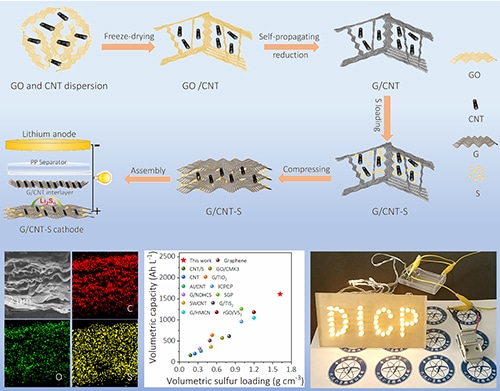May 22 2019
A team of researchers headed by WU Zhongshuai from the Dalian Institute of Chemical Physics (DICP) of the Chinese Academy of Sciences created high volumetric-energy-density and long-life lithium-sulfur (Li-S) batteries on the basis of the densely compact, free-standing, and integrated cathode.
 Schematic of 3D graphene/carbon nanotube aerogels for ultrahigh volumetric-energy-density lithium-sulfur batteries. (Image credit: SHI Haodong and HOU Xiaocheng)
Schematic of 3D graphene/carbon nanotube aerogels for ultrahigh volumetric-energy-density lithium-sulfur batteries. (Image credit: SHI Haodong and HOU Xiaocheng)
These Li-S batteries are obtained from three-dimensional (3D) interconnected porous graphene/CNT aerogels, functioning as sulfur host and interlayer at the same time. The study outcomes have been reported in Nano Energy.
Li-S batteries, a highly competitive substitute for commercially available high-energy-density lithium metal batteries, have grabbed significant attention due to their high theoretical gravimetric and volumetric energy density.
However, the practical applications of Li-S batteries have been hindered by many problems, such as low mass densities of nano-sulfur, large volume expansion of sulfur particle during cycling, inherently poor electrical conductivities of sulfur, and shuttling effect of lithium polysulfide, all of which lead to low volumetric energy density and limited cyclability of Li-S batteries.
Therefore, the limitation of the applied research of Li-S batteries is enhancing the gravimetric and volumetric energy density simultaneously, as well as prolonging the cycle stability of the Li-S batteries.
The researchers created a compact, free-standing, integrated, and conductive cathode, built by compressing graphene/carbon nanotubes aerogels, serving as bi-functionalities of binder- and metal-current-collector-free sulfur host and interlayer for Li-S batteries at the same time.
The built-in cathode exhibited high compaction density, exceptional mechanical flexibility, and high electrical conductivity, which could provide the cathode with volumetric-energy-density, ultrahigh volumetric mass density, and remarkably long-term cycling stability with a very low decay rate over 500 cycles at 2C.
This projected integration cathode approach would offer several possibilities for building binder-free, current-collector-free, high-sulfur-loading and compact cathodes toward high-volumetric-energy-density and flexible Li-S batteries.
This research was supported by the National Natural Science Foundation of China, National Key R&D Program of China, and Dalian National Laboratory For Clean Energy (DNL), CAS.